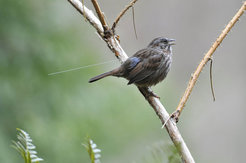Only some like it hot
How birds from different populations react to infections in their natural environment
The immune system is the most important system an organism relies on for defending itself against pathogens. All organisms have an immune system; however, it remains unclear as to why species and populations within a given species display significant variations in their immune responses. Finding answers to such questions has until now been hampered by the difficulty in recording immune responses in wild animals. With the help of advances in radiotelemetry technology, researchers from Princeton University and the Max Planck Institute for Ornithology in Radolfzell have now succeeded, for the first time, in documenting population differences in fever in a vertebrate species living in the wild, the North American song sparrow (Melospiza melodia). (Functional Ecology, March 31, 2010)

As anyone who has suffered from a cold or flu knows, fever is an unpleasant but important side effect of the body’s immune reaction when fighting off pathogens. Laboratory studies, in which the immune responses of animals could be observed in detail, have shown that these responses can vary strongly between species. Why doesn’t every organism defend its body at the maximum possible level of intensity? New immuno-ecological theories presume that immune responses are "costly", that is they compete with other energy-consuming processes such as partner selection, territorial behaviour and reproduction. Each individual has limited resources and must, therefore, enter into compromises, so-called trade-offs. This could explain why different species with different living conditions also display variations in their immune responses.
Laboratory tests can only simulate the conditions that prevail in nature to a very limited extent. In captivity, animals have unlimited access to food, enjoy pleasant climatic conditions and are not vulnerable to predators. These conveniences can result in the absence of any need to compromise when it comes to the distribution of their energy reserves.
Jim Adelman, a doctoral student at Princeton University, and a group working with Michaela Hau and Martin Wikelski at the Max Planck Institute for Ornithology in Radolfzell have now succeeded in measuring fever and sickness behaviour in various populations of a North American bird species living in the wild, the song sparrow (Melospiza melodia). For the tests, individual sparrows were caught in Southern California and in the northerly state of Washington. To stimulate the immune response in a standardised way, both groups were administered a small dose of bacterial cell walls which causes fever for a limited period of around one day. A control group was briefly captured, but left untreated. Just before release, a small transmitter weighing approximately 0.5 grams was attached to the birds’ backs and transmitted data on both their body temperatures and activities over a 20-hour period.
Interestingly enough, the "injected" sparrows showed barely any increase in body temperature during the day. However, during the night when, based on their natural biorhythms, birds reduce their metabolism and their body temperatures by three to four degrees, clear differences emerged between the two populations: the Californian sparrows recorded a body temperature of over two degrees Celsius higher than the animals in the untreated control group of this population. As opposed to this, the body temperatures of the more northern population increased by at most one degree and only during the first half of the night.
In Washington State, song sparrows have a short breeding season of around 100 days. For this reason, they probably have to invest all of their resources in reproduction; the investment of time and energy in the immune response could reduce their breeding success. In contrast, due to their longer breeding period of 150 days, the sparrows in sunny California have greater scope for compensation and can give priority to the immune reaction.
"This study represents a major step forward in our ability to study immune function in wild animals, and thereby to finally increase our understanding of the causes and consequences of variation in immune function in nature," says Jim Adelman. The study also represents an advance in terms of the possibilities available to scientists to study the processes and effects of the immune system under natural environmental conditions with the help of radio telemetry.







